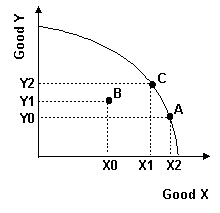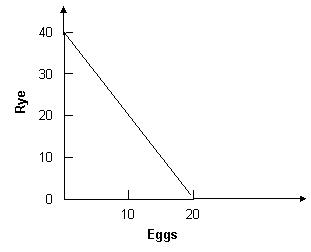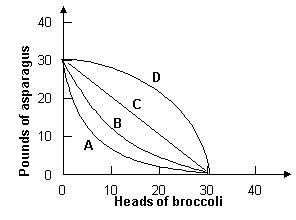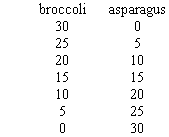 |
1 |  | 
 <a onClick="window.open('/olcweb/cgi/pluginpop.cgi?it=gif::::/olc/dl/107057/Image16.gif','popWin', 'width=270,height=283,resizable,scrollbars');" href="#"><img valign="absmiddle" height="16" width="16" border="0" src="/olcweb/styles/shared/linkicons/image.gif"> (2.0K)</a> <a onClick="window.open('/olcweb/cgi/pluginpop.cgi?it=gif::::/olc/dl/107057/Image16.gif','popWin', 'width=270,height=283,resizable,scrollbars');" href="#"><img valign="absmiddle" height="16" width="16" border="0" src="/olcweb/styles/shared/linkicons/image.gif"> (2.0K)</a>
Refer to the graph above. We can infer from the graph that this society: |
|  | A) | prefers B to C. |
|  | B) | prefers C to B. |
|  | C) | is indifferent between C and B. |
|  | D) | is not using its resources efficiently. |
 |
 |
2 |  | 
 <a onClick="window.open('/olcweb/cgi/pluginpop.cgi?it=gif::::/olc/dl/107057/Image17.gif','popWin', 'width=361,height=322,resizable,scrollbars');" href="#"><img valign="absmiddle" height="16" width="16" border="0" src="/olcweb/styles/shared/linkicons/image.gif"> (2.0K)</a> <a onClick="window.open('/olcweb/cgi/pluginpop.cgi?it=gif::::/olc/dl/107057/Image17.gif','popWin', 'width=361,height=322,resizable,scrollbars');" href="#"><img valign="absmiddle" height="16" width="16" border="0" src="/olcweb/styles/shared/linkicons/image.gif"> (2.0K)</a>
Refer to the graph above. The graph indicates that with the resources and technology it has available, Ricardia: |
|  | A) | can produce both 20 units of rye and 10 units of eggs. |
|  | B) | can produce both 40 units of rye and 20 units of eggs. |
|  | C) | cannot produce both 20 units of rye and 10 units of eggs. |
|  | D) | cannot produce both 10 units of rye and 10 units of eggs. |
 |
 |
3 |  | 
The principle of increasing marginal opportunity costs states that initial opportunity costs are __________ and they __________ the more you concentrate on the activity |
|  | A) | high; decrease |
|  | B) | low; increase |
|  | C) | high; increase |
|  | D) | low; decrease |
 |
 |
4 |  | 
Which of the following would most likely generate a negative externality? |
|  | A) | Education. |
|  | B) | A lighthouse. |
|  | C) | Cigarette smoke. |
|  | D) | Employment. |
 |
 |
5 |  | 
Marginal opportunity cost is increasing if: |
|  | A) | all inputs are equally adaptable to the production of all goods. |
|  | B) | the production possibility curve is a downward sloping straight line. |
|  | C) | all inputs are not equally adaptable to the production of all goods. |
|  | D) | each input can be used to produce more than one good. |
 |
 |
6 |  | 
Given a production possibility curve for good X (on the x-axis) and good Y (on the y-axis), the opportunity cost of increasing good X is smallest when the slope of the production possibility curve is: |
|  | A) | -6 |
|  | B) | -4 |
|  | C) | 6 |
|  | D) | 4 |
 |
 |
7 |  | 
Suppose a single firm gains control of an industry by preventing other firms from entering the industry. As a result, the price charged by the single firm is much higher than the price that would be charged by many different firms producing this product in a competitive market. This situation can best be described as: |
|  | A) | a market failure. |
|  | B) | a government failure. |
|  | C) | an efficient outcome. |
|  | D) | a competitive outcome. |
 |
 |
8 |  | 
If no resource had a comparative advantage in the production of any good, the production possibility curve would be most likely to have: |
|  | A) | an increasingly negative slope. |
|  | B) | an increasingly positive slope. |
|  | C) | a negative but constant slope. |
|  | D) | a positive but constant slope. |
 |
 |
9 |  | 
Market failures: |
|  | A) | can always be corrected through government action. |
|  | B) | can never be corrected through government action. |
|  | C) | are sometimes made worse by government failures. |
|  | D) | lead to a desired allocation of resources. |
 |
 |
10 |  | 
 <a onClick="window.open('/olcweb/cgi/pluginpop.cgi?it=gif::::/olc/dl/107057/Image18.gif','popWin', 'width=346,height=290,resizable,scrollbars');" href="#"><img valign="absmiddle" height="16" width="16" border="0" src="/olcweb/styles/shared/linkicons/image.gif"> (3.0K)</a> <a onClick="window.open('/olcweb/cgi/pluginpop.cgi?it=gif::::/olc/dl/107057/Image18.gif','popWin', 'width=346,height=290,resizable,scrollbars');" href="#"><img valign="absmiddle" height="16" width="16" border="0" src="/olcweb/styles/shared/linkicons/image.gif"> (3.0K)</a>
Refer to the graph above. Given the following production possibility table for growing broccoli and asparagus in a 320 square foot garden in one season, the relevant production possibility curve is:
 <a onClick="window.open('/olcweb/cgi/pluginpop.cgi?it=gif::::/olc/dl/107057/Image5.gif','popWin', 'width=219,height=207,resizable,scrollbars');" href="#"><img valign="absmiddle" height="16" width="16" border="0" src="/olcweb/styles/shared/linkicons/image.gif"> (1.0K)</a> <a onClick="window.open('/olcweb/cgi/pluginpop.cgi?it=gif::::/olc/dl/107057/Image5.gif','popWin', 'width=219,height=207,resizable,scrollbars');" href="#"><img valign="absmiddle" height="16" width="16" border="0" src="/olcweb/styles/shared/linkicons/image.gif"> (1.0K)</a> |
|  | A) | A |
|  | B) | B |
|  | C) | C |
|  | D) | D |
 |